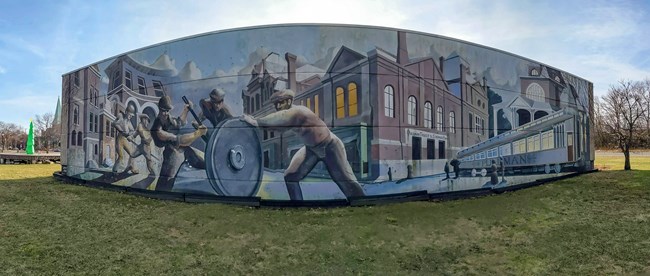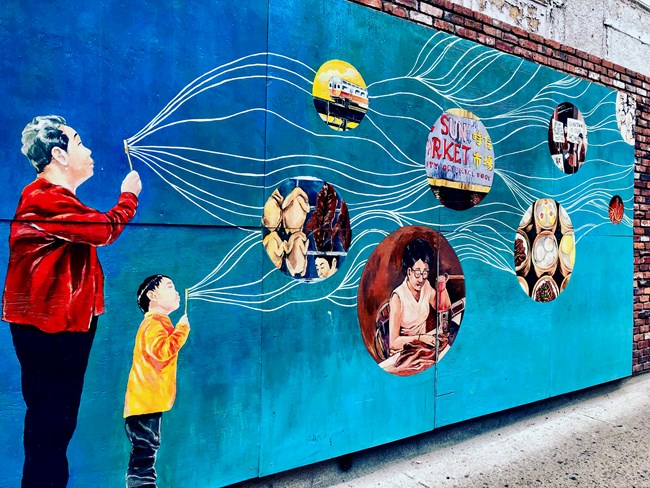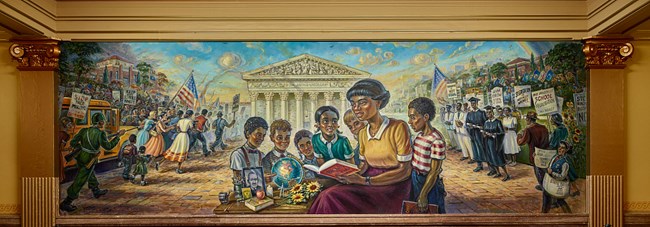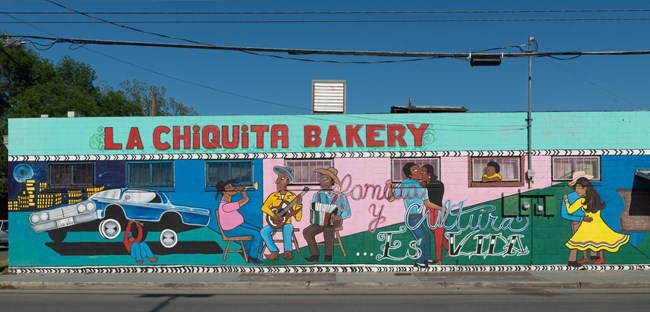Last updated: July 12, 2022
Article
Pathways Through American History: Making a Living and Making a Life

Photo by Matthew Dillon.
Marker 1 of 4: How did people secure and protect their rights in the workplace?
To put food on the table, workers first needed a seat at the table. During the late 1800s and early 1900s, workers came together to improve the workplace for themselves and others.
Changes in policy are often the end-goal of labor activism, such as union organizing, boycotts, and strikes. During the early 1900s, some labor advocates turned to policy and political institutions, bringing the struggles of ordinary people to national importance.
How can one person make a difference? What do you need from history to start working together with others?
Fighting for a Seat at the Table
-
 Article CollectionWomen in the Labor Movement
Article CollectionWomen in the Labor MovementWomen’s work has powered U.S. history, but it hasn’t always been easy. Explore stories about the struggle to improve life for women at work.
-
 Article SeriesMarching for Justice in the Fields
Article SeriesMarching for Justice in the FieldsIn 1966, Mexican American and Filipino American farmworkers went on strike in California to demand their fundamental rights as workers.
-
 PersonRosina Corrothers Tucker
PersonRosina Corrothers TuckerCivil rights and labor activist Rosina Corrothers Tucker played a pivotal role in the creation of the Brotherhood of Sleeping Car Porters.

Photo by Eric F. James. CC BY 2.0.
Marker 2 of 4: How did people start businesses to make the economy work for them?
Large and small, American businesses play a key role in keeping the economy going. They provide more than just goods and services. Businesses can employ thousands of workers, offer economic opportunities, and become important fixtures in communities.
Entrepreneurship and empowerment can go hand in hand. Owning or starting a business helped some people to overcome significant challenges.
Empowering Through Entrepreneurship
-
 (H)our History LessonMadam C. J. Walker
(H)our History LessonMadam C. J. WalkerThis lesson celebrates Madam C. J. Walker, a Black entrepreneur, and her success in business and social good.
-
 PersonHarry S. Kawabe
PersonHarry S. KawabeKawabe overcame economic hardship and Japanese incarceration to become one of Seward, Alaska’s most prosperous and popular businessmen.
-
 PersonSinrock Mary, the Reindeer Queen
PersonSinrock Mary, the Reindeer QueenSinrock Mary made her legacy as a headstrong businesswoman and interpreter for expeditions along the northern Alaska coast and Russia.
More to Explore
Entrepreneurship and empowerment can go hand in hand. Businesses can employ thousands of workers, offer economic opportunities, and become important fixtures in communities.
American Latino Theme Study: Business and Commerce
This essay explores the growth of Latino business & commerce from the Spanish & Mexican colonial periods through the 21st century.
LGBTQ Business and Commerce
Commercial enterprises played a key role in the development of local and national LGBTQ communities.
Asian American Businesses, 1848 to 2015: Accommodation and Eclectic Innovation
Businesses provided a way for AAPI innovators to foster ethnic enclaves and make a life as independent entrepreneurs.
Early Women in Banking
Between the late 19th and early 20th centuries, some women became successful leaders in the challenging, male-dominated field of banking.

Photo by Carol M. Highsmith, Courtesy Library of Congress.
Marker 3 of 4: How can education build a strong society?
There are many people—both famous and not—who brought about social change by improving access to education.
Some advocates improved educational opportunities by challenging racial, gender, and class barriers in public schools. Educators also founded schools and other institutions to teach job training, language and literacy classes, money management, and other skills.
What do you need from history to envision the life you want to make for yourself? How will you know when you've made it?
Challenging Bias in Schools
-
 PersonPatsy Mink
PersonPatsy MinkCongresswoman Mink, "Mother of Title IV," experienced race & gender discrimination that inspired her work for gender equality in education.
-
 (H)our History LessonCivil Rights and Public Education
(H)our History LessonCivil Rights and Public EducationThe lesson plans in this series guide students through conversations about school segregation and the Civil Rights movement.
-
 PersonCora Reynolds Anderson
PersonCora Reynolds AndersonAn Ojibwa educator, legislator, & public health advocate, Anderson was determined to go to college & return the benefits to her community.
More to Explore
Education can foster opportunities for personal growth, civic engagement, and creative problem-solving. The histories below chronicle how education advocates worked to extend these benefits to students in public schools and beyond.
Curiosity Kit: Nina Otero-Warren
As Santa Fe County Superintendent, Otero-Warren worked to improve education for New Mexico's Hispano and Native American communities.
Mary Tape
Almost 70 years before Brown v. Board of Education, Mary Tape fought for her daughter’s right to attend public school in California.
Alice Nugent
Suffragist Alice Nugent advocated for children and Black women's education. She supported college scholarships for Black women.
Josiah Henson
After escaping slavery, abolitionist Josiah Henson founded the settlement house Dawn Institute, where he taught trades to freedom seekers.
Curiosity Kit: Nannie Helen Burroughs
Burroughs founded the National Training School for Women and Girls so that Black women could receive an education and job training.
Susan Paul
Educator & abolitionist Susan Paul instilled a commitment to social justice, action, & change in her students.

Photo by Carol Highsmith. Courtesy Library of Congress.
Marker 4 of 4: How do customs and activities bring us together?
Work is only part of our lives. There are many activities and traditions associated with leisure and recreation. How do you like to spend your free time?
Culture offers an important way to forge community and build social networks. The meals we share, songs we sing, and art we create can help us understand who we are.
How does culture shape your community and relationships? What parts of American culture reflect who you are?
Creating Culture
-
 PlaceCasa Amadeo
PlaceCasa AmadeoCasa Amadeo is the oldest continuously occupied Latin music store in NYC and played a central role in the Puerto Rican migration experience.
-
 PlaceMosquito Beach Historic District
PlaceMosquito Beach Historic DistrictMosquito Beach embodies the empowerment and entrepreneurship displayed by Charleston's coastal Black community during Jim Crow segregation.
-
 ArticleWeaving Strength in Women
ArticleWeaving Strength in WomenHuna women gather to weave together on winter weekends. They weave strength through stories, food, and knowledge in this ancestral practice.
More to Explore
From roadside attractions to the taste of home, the resources below celebrate the role of recreational and cultural activities in American life.
Travel Route 66
Discover the historic hotels, filling stations, restaurants, and more that line this iconic roadway.
Curiosity Kit: African American Baseball
Discover the historic ballparks where Black ballplayers overcame Jim Crow segregation & inspired community pride.
LGBTQ Sport and Leisure
LGBTQ athletes frequently sought a place in mainstream athletic cultures, and occasionally created their own.
The Superpower of Singing: Music and the Struggle Against Slavery
Discover how enslaved Black Americans found solace & strength in singing, for the purposes of recreation, prayer, work, & social commentary.
LGBTQ Art and Artists
The places in this chapter provide a sampling of LGBTQ contributions to everything from performance to visual artistic movements.
Tumacácori - Cooking Ramada
By reflecting the mixing of origins, chiles, carne asada, & tortillas embody the cultural heritage & colonial history of Tumacácori.
Keep Up the Pace
We make the world better by working together. How can you be of service to the people around you?
Get Off the Beaten Path
The content for this article was researched and written by Jade Ryerson, an intern with the Cultural Resources Office of Interpretation and Education.
Tags
- pathways through american history
- labor history
- labor movement
- labor reform
- labor unions
- business history
- economic history
- education
- educator
- education history
- women and education
- cultural heritage
- art
- entertainment history
- entertainment
- leisure
- recreation
- travel
- community
- women and the economy
- shaping the political landscape
- women and politics

